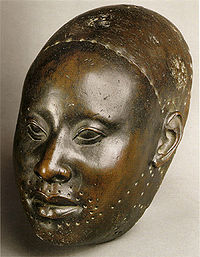Our website is made possible by displaying online advertisements to our visitors.
Please consider supporting us by disabling your ad blocker.
Yoruba art

The Yoruba of West Africa (Benin, Nigeria and Togo) are responsible for a distinct artistic tradition in Africa, a tradition that remains vital and influential today.[1]
| Part of a series on |
| Yorùbá people |
|---|
 |
Much of the art of the Yoruba, including staffs, court dress, and beadwork for crowns, is associated with the royal courts. The courts also commissioned numerous architectural objects such as veranda posts, gates, and doors that are embellished with carvings. Other Yoruba art is related shrines and masking traditions. The Yoruba worship a large pantheon of deities, and shrines dedicated to these gods are adorned with carvings and house an array of altar figures and other ritual paraphernalia. Masking traditions vary regionally, and a wide range of mask types are employed in various festivals and celebrations.[2]
- ^ Drewal, Henry John; Pemberton III, John; Abiodun, Rowland (1989). Wardwell, Allen (ed.). Yoruba : nine centuries of African art and thought. New York: Center for African Art in Association with H.N. Abrams. ISBN 0-8109-1794-7.
- ^ Adande, Joseph; Siegmann, William C.; Dumouchelle, Kevin D. (2009). African art a century at the Brooklyn Museum. Brooklyn, NY: Brooklyn Museum [u.a.] p. 106. ISBN 978-0-87273-163-9.
Previous Page Next Page


